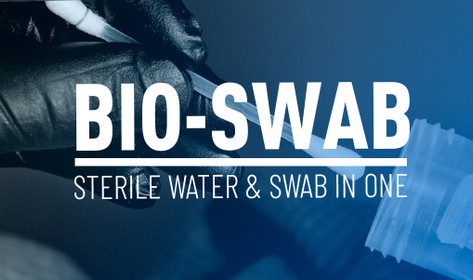Posted by QC on 6th Mar 2022
Product of the Week: Bio Swab Applicator
Touch DNA exists where a perpetrator has touched a surface at the crime scene, possibly leaving a fingerprint, as well as DNA, behind. Having the proper supplies on the scene, and the knowledge to use them, is critical to the collection of usable DNA samples. A crime scene investigator’s toolkit should include the basic and necessary supplies to recover DNA evidence from the crime scene. The supplies that are normally used for processing and recovering DNA samples include sterile cotton-tipped applicators (swabs) on which to collect samples, sterile water or a phosphate saline solution to moisten the swab prior to collection, and plastic pipettes to transfer the sterile water to the swab. Proper swabbing techniques for touch DNA are described in below:
1. Be sure to wear appropriate Personal Protective Equipment.
2. If using a dry swab, extract distilled water from vial using sterile pipette and apply one drop to the side of the tip. Do not use more than one drop, and do not dip the swab into the water.
3. If using a self-saturating cotton-tipped swab, open and remove swab holding foam tip facing down. Then squeeze handle until it pops, releasing medium into tip.
4. Apply tip to sample area and rub using moderate pressure while rotating the swab to ensure the entire swab surface has made contact with the object.
5. To avoid compromising the sample by redepositing specimen, do not rotate more than once.
6. If using dry swab, allow to air dry then place tip in proper packaging.
7. If using self-saturating cotton-tipped swab, gently peel foam tip away from handle and place in sterile container for transport.
8. Label the tube or envelope with identifying information.
9. Use evidence tape to seal outer packaging. Initial and date for chain of custody verification.
10. Store swab at room temperature or transfer to freezer until testing.
Helpful processes for swabbing biological materials are detailed below:
1. After putting on protective gloves, remove the swab from its wrapper, taking precautions to touch only the handle.
2. If the sample is dry, pre-moisten the swab tip with sterile distilled water. Place the tip of the swab on the surface, rotating slightly to allow any DNA to absorb into the fibers.
3. Allow the sample to air dry by placing the swab tip-first into the proper packaging and label. Once the swab is in the packaging, this can be placed inside an envelope or paper form. Keep the sample refrigerated until returning to the lab.
Note: all other hazardous material should be placed and labeled in separated bags.
The Bio-Swab™ is a pre-filled, individually wrapped, gamma radiated, sterile cotton tipped applicator that will deliver the exact amount of water to collect a DNA sample. This packaging system eliminates the need for carrying sterile water and will further protect from cross contamination. Lot number on every package. SDS sheet available upon request.
In addition to swabbing, samples may be cut from items or scraped from surfaces. Conferring with laboratory personnel may help to establish which collection method is preferred for a particular type of evidence. Forensic Magazine has eight rules to minimize Touch DNA contamination at a crime scene:
- Limit access to the crime scene or evidence.
- Do not talk over the evidence.
- Wear Personal Protective Equipment, including face masks.
- Change gloves frequently after handling evidence.
- Do not touch areas on evidence that may be sampled for DNA.
- Collect elimination samples from those who have been in contact with the evidence or scene.
- Use disposable fingerprint brushes and powder.
- Clean each crime scene tool coming into contact with evidence.


